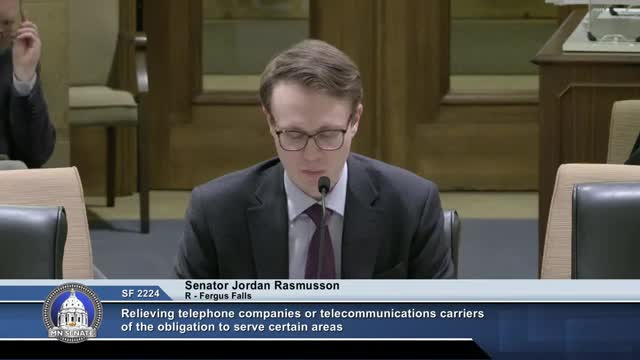Senate File 22-2024 aims to modernize Minnesota telecom policy and eliminate copper wires
March 20, 2025 | 2025 Legislature MN, Minnesota
This article was created by AI summarizing key points discussed. AI makes mistakes, so for full details and context, please refer to the video of the full meeting. Please report any errors so we can fix them. Report an error »

In a recent meeting of the Minnesota Legislature's Committee on Commerce and Consumer Protection, lawmakers discussed significant reforms to the state's telecommunications regulations, particularly focusing on the transition from traditional copper wire services to modern voice over Internet Protocol (VoIP) systems. This shift is driven by the declining demand for landline services and the need for more efficient and reliable communication options.
Historically, Minnesota's telecommunications landscape was dominated by a single provider, with regulations in place to ensure service availability in rural areas. However, advancements in technology and the introduction of competitive services have rendered many of these regulations outdated. Currently, less than 2% of U.S. households rely solely on landlines, with Minnesota reporting around 150,000 copper wire subscriptions out of 8 million total voice services.
The proposed legislation, Senate File 02/2024, aims to align Minnesota's telecom policies with contemporary broadband efforts while safeguarding consumers. Key provisions include reforming the "carrier of last resort" obligations, which currently require providers to maintain aging copper networks despite dwindling demand. The bill stipulates that these obligations can be lifted if consumers have access to affordable VoIP alternatives, ensuring that those without such options can retain their landline services.
Testimonies from industry representatives highlighted the challenges posed by copper theft, which has surged recently, causing significant disruptions for customers. The transition to fiber optics is seen as a solution to enhance network security and reliability, as fiber has no resale value for thieves. Stakeholders emphasized the importance of a smooth transition for consumers, particularly low-income individuals and the elderly, who may struggle with the shift to new technologies.
While the bill has garnered support from various telecom providers and stakeholders, concerns remain regarding the adequacy of consumer protections during the transition. The Department of Commerce raised issues about mapping accuracy, regulatory oversight of VoIP providers, and the need for clear communication with consumers about their options.
As the committee prepares to advance the bill, discussions will continue to address these concerns, aiming to ensure that all Minnesotans can access reliable telecommunications services as the state moves toward a more modern infrastructure. The outcome of this legislation could significantly reshape the telecommunications landscape in Minnesota, reflecting broader trends in technology and consumer needs.
Historically, Minnesota's telecommunications landscape was dominated by a single provider, with regulations in place to ensure service availability in rural areas. However, advancements in technology and the introduction of competitive services have rendered many of these regulations outdated. Currently, less than 2% of U.S. households rely solely on landlines, with Minnesota reporting around 150,000 copper wire subscriptions out of 8 million total voice services.
The proposed legislation, Senate File 02/2024, aims to align Minnesota's telecom policies with contemporary broadband efforts while safeguarding consumers. Key provisions include reforming the "carrier of last resort" obligations, which currently require providers to maintain aging copper networks despite dwindling demand. The bill stipulates that these obligations can be lifted if consumers have access to affordable VoIP alternatives, ensuring that those without such options can retain their landline services.
Testimonies from industry representatives highlighted the challenges posed by copper theft, which has surged recently, causing significant disruptions for customers. The transition to fiber optics is seen as a solution to enhance network security and reliability, as fiber has no resale value for thieves. Stakeholders emphasized the importance of a smooth transition for consumers, particularly low-income individuals and the elderly, who may struggle with the shift to new technologies.
While the bill has garnered support from various telecom providers and stakeholders, concerns remain regarding the adequacy of consumer protections during the transition. The Department of Commerce raised issues about mapping accuracy, regulatory oversight of VoIP providers, and the need for clear communication with consumers about their options.
As the committee prepares to advance the bill, discussions will continue to address these concerns, aiming to ensure that all Minnesotans can access reliable telecommunications services as the state moves toward a more modern infrastructure. The outcome of this legislation could significantly reshape the telecommunications landscape in Minnesota, reflecting broader trends in technology and consumer needs.
View full meeting
This article is based on a recent meeting—watch the full video and explore the complete transcript for deeper insights into the discussion.
View full meeting
